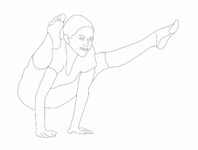What is Nauli Kriya?
Nauli is taken from the root word ‘Nāla’, which means navel string or rectus abdominis muscles. Nauli is a practice of contracting and isolating the rectus abdominis muscles. In the Gheraṅḍasaṁhitā, it is known as Lauliki. The meaning of Naulī is given as a kind of Self-penance. Simply put, it is an abdominal massage wherein the abdomen is leaned forward, protruding the belly and quickly rotating (the muscles) from right to left. This is called Naulī by the Siddhas.

Nauli Kriya Yoga step-by-step instructions
- Stand erect with feet apart with a distance of about one and a half feet, hands by the side of the thighs. Inhale deeply.
- Bend forward and place the hands above the respective knees.
- Exhale completely; pull the abdomen in by performing Uḍḍīyānabandha, forcing the rectus abdominis to pull upwards so that they form a central arch running vertically in front of the stomach.
- Release the Uḍḍīyānabandha; stand up and inhale slowly.
- Repeat the practice. Repeated attempts will finally be successful, and the rectus abdominis will stand out.
- While doing this exercise, one can look at the abdomen to see how far they succeeded in their attempt.
- Don’t feel discouraged by failure at the initial stage. After ten or twelve days of practice, one can control the rectus abdominis.
- Those who do this particular exercise should take gruel or rice pudding afterwards.
Variations
- All of the below three practices require proficiency in Uḍḍīyānabandha with the ability to hold external breath retention (Bāhyakumbhaka) for some time.
- Madhyanaulī (Middle Rotation): Perform Uḍḍīyānabandha, then contract the rectus abdominal muscles so that they form a central arch running vertically in the front of the abdomen. Repeat the practice with Uḍḍīyānabandha.
- Dakṣiṇanaulī (Right Rotation): Perform Madhyamanaulī, then isolate the right side of the rectus abdominal and contract as strongly as possible without straining; return to Madhyamanaulī. Dakṣiṇanaulī becomes more manageable if you lift the left hand from the knee and keep all the pressure on the right hand and knee. This will automatically isolate the rectus abdominal muscles on the right side.
- Vamanauli (Left Rotation): Perform Madhyamanaulī, then isolate the left side of the rectus abdominal and contract as strongly as possible without straining; return to Madhyamanaulī. Vāmanaulī becomes more manageable if you lift the right hand from the right knee and keep all the pressure on the left hand and knee. This will automatically isolate the rectus abdominal muscles on the left side.
- After the above has been mastered, abdominal rotation (‘churning’) can be achieved by rolling from Vāma to Dakṣiṇa and Dakṣiṇa to Vāma, gradually working up to several consecutive cycles.
Precautions
- Those suffering from heart disease, hernia, hypertension, gastric or duodenal ulcers (and during pregnancy) should not practise it. People recovering from internal injury or surgery of the abdomen also should not perform it.
- The practice should be discontinued immediately if pain is felt in the abdomen during exercise.
Contraindications and Limitations
- Those who are suffering from any severe ailment, such as:
- High blood pressure
- Gallstones
- Hernia
- Peptic or duodenal ulcer shouldn’t practice this yoga pose.
- Pregnant women should not practise nauli.
Benefits
- According to Haṭhapradīpikā, it is the foremost of the Haṭhayoga practices. It kindles the digestive fire, removing indigestion, sluggish digestion, and all disorders of the doṣa, and brings about happiness.
- The rolling, rotation and agitation of the entire abdomen during Naulī gives deep massage and profound toning to all the abdominal muscles and organs.
- It generates heat in the body and stimulates digestive fire.
- It balances the endocrine functions, regulates hormones, and positively changes emotional states.
- It helps reduce constipation, acidity, flatulence, lethargy, diabetes, and sexual and urinary disorders.
Spiritual Benefits
On an esoteric level, Naulī has a profound effect on Prāṇamaya kośa and Manomaya kośa, develops mental clarity, and increases the store-house of prāṇa in Maṇipūrcakra.
Scientific Explanation of Nauli
Naulī is an excellent example of developing control over those muscles which we hardly use individually and about which most people are unaware. The rectus abdominis form the front linear wall of the abdominal cavity and is used with other muscles like the transverses abdominis. Contracting the rectus abdominis individually and independently depends on a willful dissociation of their functions from the other adjoining groups of muscles. Once trained in the method of individual motivation of these muscles of either side, great control can be acquired on the pressure dynamics of the abdomen. The rotation of the rectus abdominis muscles improves the mobility of the various visceral organs and activates the nerve plexuses and their exemplary terminals. This would result in the development of better coordination between autonomic functions. This also develops the capacity to produce negative pressure in the abdomen. This, on the one hand, sucks up more blood in the stomach and, on the other, allows greater control on the rate at which various substances can be ejected out of the abdominopelvic hollow viscera, e.g. the evacuation of faeces, urine, and other genito-urinary secretions. The Naulī action also provides a kind of massage to all the abdominal organs.
Duration
The beginner should do only a few rounds. If you are trying to master madhyama nauli, five or six games are more than sufficient initially. With practice, one can do a maximum of about ten rounds. If you are trying to master Vama and Dakshina Nauli, three to five games each is sufficient.







You realize significantly in the case of this topic. The stuff is nice. All the time care for it up!